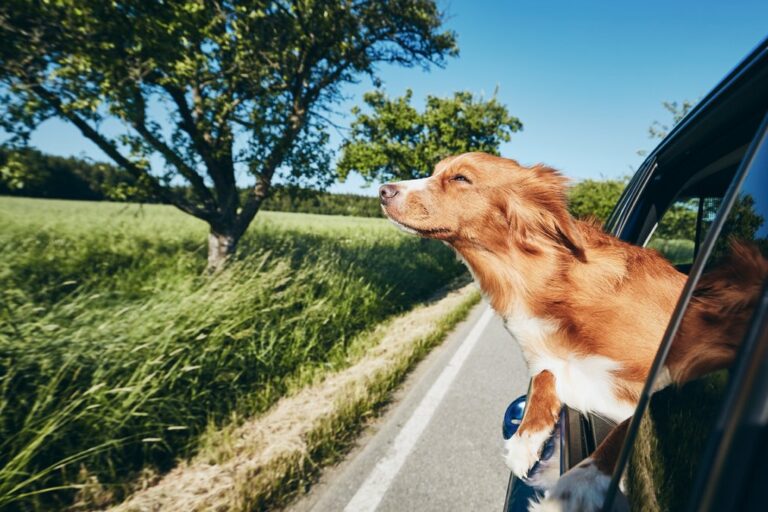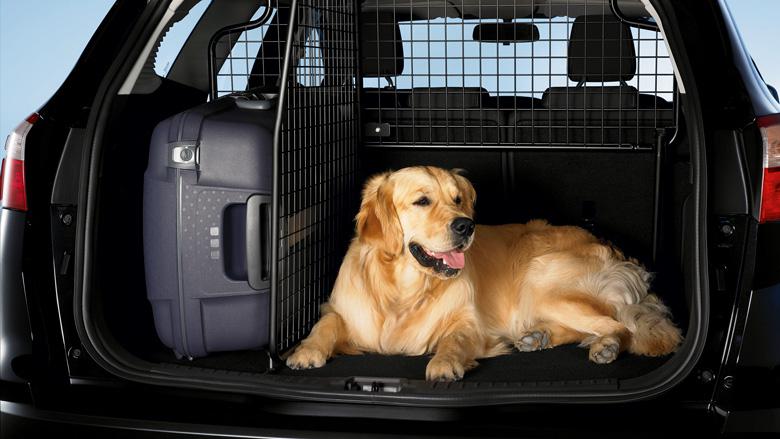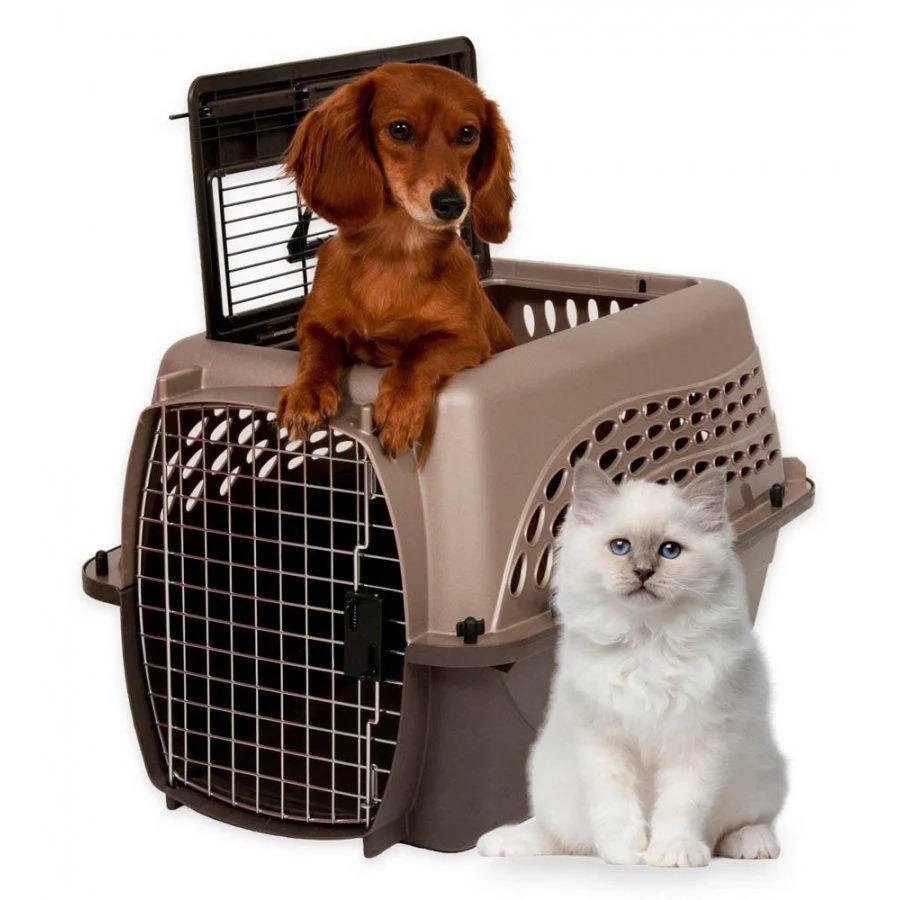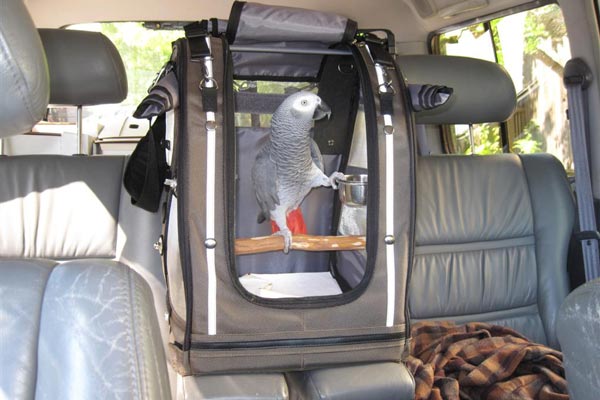Transporting pets in a car: Safe travel rules
In our time, traveling with pets is a commonplace car. On vacation, at the cottage, or just to the vet: we often have to bring the animal with us to the salon of the car. And it doesn’t matter, whether it’s a massive dog, a small cat, a fussy chimpanzee, hand hamsters or a cold blooded reptile, we should take care of. As the animal itself, which can be frightened or injured while traveling, and the safety of its transportation, non-compliance with which may cause an accident.
A properly unattached animal, or even if attached, but hungry or disturbed, can distract the driver and interfere with driving. And in the event of a sudden stop or collision, the lack of special means of transportation or secure attachments turns the animal into a projectile that can not only injure other passengers, damage the cabin, but also cause serious injury or death. For example, in a typical road accident at a speed of 50 km / h, a dog weighing 20-25 kg will fly forward with an impact force of about 700 kg.
The conditions and rules for the carriage of pets by road in Ukraine are not as standard as passengers, but no less important. The CMU Resolution “On Approval of the Rules for the Transport of Animals” (hereinafter – the Rules) of November 16, 2011 №1402, which defines the requirements for the commercial transportation of animals by air, road, rail, sea and river transport, contains a short section on the peculiarities of transportation of pets. It is more concerned with transportation by rail, air, public transport. Only paragraph 44 of the Rules for the Carriage of Pet Animals by Motor Vehicle in the Vehicle Lounge states that “it is permissible to carry small animals in baskets, bags with a solid bottom, birds in cages, dogs in muzzles in the presence of a leash, provided that animals do not contaminate the passenger compartment and belongings and are placed on the floor, and in the presence of litter – in the seat (during transportation by taxi). The existing Traffic Rules also, strangely enough, do not have separate requirements for the carriage of pets. There, they are generally equated with cargo: that is, the main thing is that the cargo does not interfere with the driver while operating the vehicle.
Therefore, those who are often forced or willing to travel with their pet car, you need to understand – you may not be fined for improper transportation, but failure to comply with basic safety standards can play an evil joke with you. By the way, this can only be called a joke on Ukrainian roads. When crossing the border, the rules may change – and this should also be taken into account.
With that in mind, we’ve put together some recommendations for transporting pets in a car to make your trip with your pet not only comfortable but also safe. Of course, the choice of means of transportation will depend on the animal (its species, weight, peculiarities of temperament and behavior, mode, etc.) and the capabilities of the car.
Safe transportation of dogs
Dogs are the most common companion when traveling by car. Due to their character, high attachment to their owners, variety of breeds and sizes, today there are many tools available on the market that make it possible to make a trip with a four-legged friend in the salon the most convenient. In terms of quality, reliability, and most importantly safety, the most common of these tools was mentioned in a recent New York Times article.
For example, experts at the American Independent Pet Safety Center, which tests and certifies vehicles for the safe transportation of animals in a car, emphasize that the means of transportation should cover two purposes – to prevent driver distraction, ie to keep the animal out of the front seat – and to protect against accidents secure the animal or container with the animal to prevent injury.
Many families nowadays opt for dog sledding, which is considered to be the most practical trade-off between protection and comfort. It is a vest with a strap around the neck and front paws with the main support on the chest and connects to the seat belt of the car. Center experts point out that the belt should pass through the point of attachment of the harness on the dog’s back. Extension cords that connect the harnesses to the safety sockets must be securely attached. And in no case should the harness attach to a normal collar.
Watch video example: https://www.youtube.
An alternative is the so-called zip-line, a belt that runs along the rear seat wall or the top of the cabin and attaches to its fixed parts. The harness that connects the harness to the harness allows the dog to feel free in the back seat and in the event of an accident, will not allow any impact on the front seat and inside the cabin. However, the Safety Center does not approve of lightning, considering that this design is not entirely reliable and is at high risk of injury to both the animal and those nearby.
Watch video: https://www.youtube.
Another popular product that is not certified by the Animal Safety Center is a travel seat – a booster designed to lift a dog so it can look out the window. This option, according to experts, has a high risk of animal ejection due to a window accident or injury to glass fragments. In addition, the popular transportation of a dog with its head out of the window is also quite detrimental to the animal’s health: stretching can cause inflammation of the ears or eyes.
A properly unattached animal, or even if attached, but hungry or disturbed, can distract the driver and interfere with driving. And in the event of a sudden stop or collision, the lack of special means of transportation or secure attachments turns the animal into a projectile that can not only injure other passengers, damage the cabin, but also cause serious injury or death. For example, in a typical road accident at a speed of 50 km / h, a dog weighing 20-25 kg will fly forward with an impact force of about 700 kg.
The conditions and rules for the carriage of pets by road in Ukraine are not as standard as passengers, but no less important. The CMU Resolution “On Approval of the Rules for the Transport of Animals” (hereinafter – the Rules) of November 16, 2011 №1402, which defines the requirements for the commercial transportation of animals by air, road, rail, sea and river transport, contains a short section on the peculiarities of transportation of pets. It is more concerned with transportation by rail, air, public transport. Only paragraph 44 of the Rules for the Carriage of Pet Animals by Motor Vehicle in the Vehicle Lounge states that “it is permissible to carry small animals in baskets, bags with a solid bottom, birds in cages, dogs in muzzles in the presence of a leash, provided that animals do not contaminate the passenger compartment and belongings and are placed on the floor, and in the presence of litter – in the seat (during transportation by taxi). The existing Traffic Rules also, strangely enough, do not have separate requirements for the carriage of pets. There, they are generally equated with cargo: that is, the main thing is that the cargo does not interfere with the driver while operating the vehicle.
Therefore, those who are often forced or willing to travel with their pet car, you need to understand – you may not be fined for improper transportation, but failure to comply with basic safety standards can play an evil joke with you. By the way, this can only be called a joke on Ukrainian roads. When crossing the border, the rules may change – and this should also be taken into account.
With that in mind, we’ve put together some recommendations for transporting pets in a car to make your trip with your pet not only comfortable but also safe. Of course, the choice of means of transportation will depend on the animal (its species, weight, peculiarities of temperament and behavior, mode, etc.) and the capabilities of the car.
Safe transportation of dogs
Dogs are the most common companion when traveling by car. Due to their character, high attachment to their owners, variety of breeds and sizes, today there are many tools available on the market that make it possible to make a trip with a four-legged friend in the salon the most convenient. In terms of quality, reliability, and most importantly safety, the most common of these tools was mentioned in a recent New York Times article.
For example, experts at the American Independent Pet Safety Center, which tests and certifies vehicles for the safe transportation of animals in a car, emphasize that the means of transportation should cover two purposes – to prevent driver distraction, ie to keep the animal out of the front seat – and to protect against accidents secure the animal or container with the animal to prevent injury.
Many families nowadays opt for dog sledding, which is considered to be the most practical trade-off between protection and comfort. It is a vest with a strap around the neck and front paws with the main support on the chest and connects to the seat belt of the car. Center experts point out that the belt should pass through the point of attachment of the harness on the dog’s back. Extension cords that connect the harnesses to the safety sockets must be securely attached. And in no case should the harness attach to a normal collar.
Watch video example: https://www.youtube.
An alternative is the so-called zip-line, a belt that runs along the rear seat wall or the top of the cabin and attaches to its fixed parts. The harness that connects the harness to the harness allows the dog to feel free in the back seat and in the event of an accident, will not allow any impact on the front seat and inside the cabin. However, the Safety Center does not approve of lightning, considering that this design is not entirely reliable and is at high risk of injury to both the animal and those nearby.
Watch video: https://www.youtube.
Another popular product that is not certified by the Animal Safety Center is a travel seat – a booster designed to lift a dog so it can look out the window. This option, according to experts, has a high risk of animal ejection due to a window accident or injury to glass fragments. In addition, the popular transportation of a dog with its head out of the window is also quite detrimental to the animal’s health: stretching can cause inflammation of the ears or eyes.

By far, the safest solution for transporting a dog is a special container or box, the fastenings of which are fastened to the seat belts or secured by ties. In newer cars, it can be a LATCH or Isofix lock, like the one used in child seats. Ideally, when in the car it is possible to place such a box in the luggage area or compartment, where the animal will feel free and at the same time will not disturb anyone. Unfortunately, this option is not suitable for all cars. And a four-legged friend should be accustomed to such transportation from a young age and not be afraid of the enclosed space.

Whatever the choice, the Pet Safety Center is convinced that the means of transportation must meet safety standards, be certified or approved by a laboratory. A certified product will typically have a higher price tag, but it will be an investment in protecting animals and property. It also protects against further costs that may be associated with the treatment and recovery of the animal following an accident.
When planning a trip with a dog, they recommend feeding only half of the animal, making frequent stops to drink and walk. If you are traveling long or traveling abroad, you should bring your dog’s passport and vaccination card, and be sure to be aware of the animal transportation features in the country of destination.
Safe transportation of cats, rabbits, raccoons, large rodents

For cats, rabbits, rabbits and large rodent breeds, the same carriage principle applies as for small breeds of dogs. Ideal for them is a special carry-on bag, a container (box) or a cage, which can be attached in the luggage compartment, and in its absence, in the back seat or under it. Make sure that the retainers are secure and that the attachment points are fixed. Carry the size of the carriage or installation to the size of the animal, and it is important that it is well closed and ventilated.
Usually, cats are more difficult to tolerate the road, unlike dogs. They may be frightened by noise, interfering with even the smallest draft. Therefore, be sure to check that the windows are closed. Especially timid is recommended to give a few drops of soothing: so the road will be easier. Like dogs, it is advisable for cats to be fed halfway so as not to cause nausea, but take care of water or timely watering. Rodents should always be provided with drinking water and light treats.
Safe transportation of birds and small rodents

Small boxes with air openings will be suitable for transporting this category of pets (small parrots, hamsters, guinea pigs, etc.). For larger breeds of parrots, such as cockatoos or Amazons, you can also use a cat carry. Ideal for a special container purchased from a pet store. But their reliable fixing in the car interior is also worth taking care of. It is not recommended to carry a box or box on your hands: in the event of an accident, they can injure passengers or block the exit of the car.
Animals of this type are usually not transported in their cages: rapid flickering of pictures in front of the eyes can cause stress, and throwing them on the cage or hitting it as a result of the car’s movement will cause incompatibilities with life.
As with animals, cold and drafts are the worst enemies of bird health. Therefore, the cabin maintains a temperature that is familiar to their lifestyle.
Safe transportation of fish and reptiles

For such creatures, it is always important for them to have a personal space and to keep to the conditions in which they are accustomed to being. Therefore, for transportation of lizards, turtles, chameleons, snakes, etc., choose containers or containers that can provide them with such conditions. From a safety point of view, the principle is the same – the secure fixing of the container or container, if it is a salon. Fish are safer to transport in plastic bags rather than glass jars.
So, the basic principles that should be followed for the safe transportation of pets during road trips are:
- the location and fixation of the place of carriage of the animal outside the front seat;
- providing comfort for the animal and at the same time safety for passengers;
- avoidance of the animal’s influence on compliance with the traffic rules by the driver;
- the choice of special means of transportation that meet safety standards;
- reliable attachment of any means of transportation of the animal;
- compliance with domestic and international animal transportation legislation.
We wish you and your pets only safe trips!
CONTACT US
-
Address: Kyiv, Ukraine 55-G Velyka Vasylkivska Str.
PO Box 217 - Phone: + 38 (044) 466 43 81
- E-mail: fond@dopomogadtp.com
- 2021 All rights reserved



